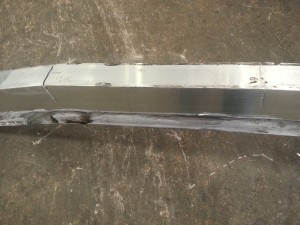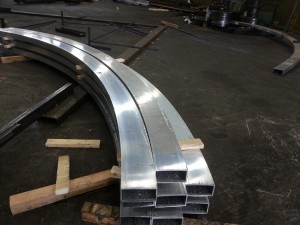Often, in the rolling and bending industry, we field requests asking about the minimum radius to which we can roll or bend a piece. In some instances, an estimator can quickly say yes or no based on prior knowledge and bending experience. There are many factors to take into account when determining the minimum radius such as the material composition, shape, and size. A 2” carbon steel pipe will have a different minimum radius from a thin wall 2” aluminum tube.
In some instances, a rough guide for minimum radius bending would be to use a multiple of the piece diameter. For example, on a 2 inch pipe elbow, common bend measurements may be referred to as 2D, 3D, or 5D. In these cases, the 2D would reference a centerline bend radius of two times the diameter. 2D = 4 inches, 3D = 6 inches, and 5D = 10 inches for a 2 inch diameter pipe. This type of bending is usually performed on a rotary draw bender for speed and precision, which requires specific tooling built for each bend. So, even though it may be possible to give a piece a 2D or 3D bend, a 3.5D bend may be more difficult because the tooling is not on hand. For tight rotary draw bending, maintaining a bend radius that is a whole number multiple may increase the capability of the steel bender to meet your needs. While it may not be a minimum for every bender, a 3D bend radius is a commonly used starting point for minimum radius bends.
As a piece size gets larger, pre-made tooling for tight bends will be less common. In these cases, the minimum radius will likely need to increase beyond a 3D size. Another important factor to consider when looking at pipe or tubing is the wall thickness of the piece to be bent. Increasing the wall thickness on a tight radius bend generally improves the final quality of a rolled tube as well as lowers the minimum radius a piece can be rolled with minimal distortion issues.
Material used can also change the minimum bend radius. One previous job which provides a good example of this used some 8 x 4 aluminum tubing rolled the hardway to a 16 foot radius. The same tubing rolled in carbon steel could be pulled much tighter. However, the aluminum tubing began to crack, possibly due to age-hardening coupled with the tight radius. To solve the issue, the material was sent out to be stress-relieved before rolling was continued. In the end, this caused a much improved final product for the customer with no additional material cracking issues.


As you can see, determining the minimum bend radius for a piece has many factors to take into account. Available tooling, tube size, material thickness and composition are all components that can add into what the minimum bend radius is for a piece of metal. In these situations, locating a bender/roller with the prior experience in handling these tough and tight bending jobs can be very helpful.







